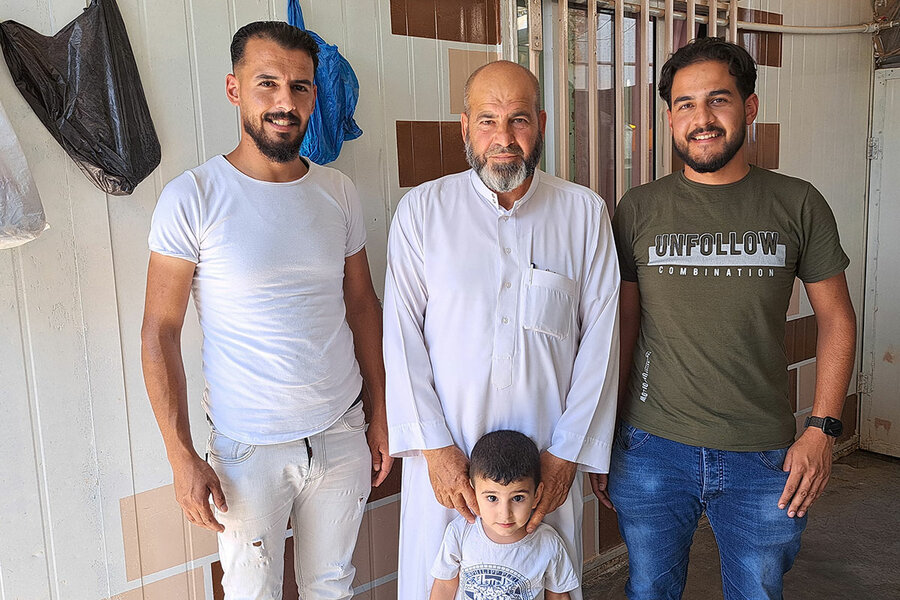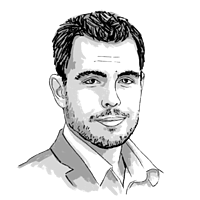Not gone, but forgotten? Syrian refugees struggle to move forward.
Loading...
| Zaatari, Jordan
In its first years, the Zaatari Refugee Camp in northern Jordan made headlines for cutting-edge innovation: prefabricated housing, sewage and water systems, schools, the world’s first solar power plant in a refugee camp.
Yet today the homes are well past their six-year shelf life, and it shows. Floors are cracked, roofs are collapsing, and mold is spreading. U.N. staff warn the vast majority of the 26,000 trailers require urgent renovation. But unfulfilled hopes for the Syrian refugees here are a greater concern, they say.
Why We Wrote This
A story focused onAn outpouring of international generosity and compassion a decade ago created a refuge for Syrians fleeing civil war, offering them security, stability, dignity, and hope. What happens when the world’s focus moves on?
“When we first arrived in Jordan our needs were shelter, food, and safety – which we were graciously provided by Jordan and the international community,” says Mohammed Hariri, who fled Syria in 2012 with his family. “Now we worry about ... securing futures for our children.”
Jordan, with a 25% unemployment rate, allows Syrians only to work in agriculture, manufacturing, restaurants, and construction. The best Syrian university graduates can hope for is a volunteer position with the U.N. Meanwhile, scholarships for Syrian students in Jordan have dried up.
Officials say that sends a hope-dashing message.
“The worry,” says UNHCR spokesperson Roland Schoenbauer, “is an entire generation will give up on their future and say, ‘I’ll sell vegetables or get my humanitarian assistance and sit and wait like everyone else.’”
Gone are the Hollywood A-listers who once walked this refugee camp’s dusty streets as regularly as down-the-street neighbors.
The gleaming white trailers that once adorned glossy pamphlets highlighting NGO success stories in the Zaatari camp are weather-beaten, gray, cracked, and leaking.
The colorful murals of Damascene courtyards painted on their sides, meant to console or inspire their inhabitants, have faded in the desert sun.
Why We Wrote This
A story focused onAn outpouring of international generosity and compassion a decade ago created a refuge for Syrians fleeing civil war, offering them security, stability, dignity, and hope. What happens when the world’s focus moves on?
Even the constant stream of high-profile journalists and Western leaders – who used this barren border location as a backdrop for news reports and carefully curated media tours to discuss the Syrian conflict a few miles away – has dried up.
An outpouring of international generosity and compassion prompted by the horrors of Syria’s civil war created this refuge, providing its residents – for a time – with security, stability, dignity, and hope after the trauma of fleeing their homes.
Yet what remains here 10 years later are more than 80,000 Syrian men, women, and children whose futures and potential return to their homeland are no more settled now than when war drove them to flee.
“Ten years on and we cannot move forward with our lives or move back,” says camp resident Abu Shadi. “It is as if the world has forgotten us.”
With the world’s attention drawn to new crises and conflicts – from COVID-19 to Russia’s war in Ukraine – focus and funds have dried up for one of the world’s largest unresolved refugee crises.
For the Syrians here and the host country that cannot afford to host them, that deflected focus raises questions of how to maintain dignity amid deflated hopes, and what is fair in a world with limited resources.
Evolving needs
The Zaatari Refugee Camp only houses a fraction of the 670,000 registered Syrian refugees in Jordan, most of whom burden the resource-poor kingdom’s crowded urban centers, but it is a potent symbol.
In its first years, Zaatari, 50 miles north of Amman, made headlines for cutting-edge innovation in what was initially an emergency desert camp: prefabricated housing, sewage and water systems, schools and a soccer field, the world’s first solar power plant in a refugee camp.
Yet everything in Zaatari is temporary; even relief workers with the United Nations and the Jordanian police work out of trailers.
Mohammed Hariri, who was among Zaatari’s first residents, says needs have evolved with the years.
When he fled his home in Daraa with his children and then-pregnant wife and arrived here in August 2012, their priorities were straightforward: shelter from the dust storms that tore at camp tents, safe access to shared bathrooms, and carrying two 20-liter jerrycans of water 200 yards back to their tent twice a day.
Now they have a private bathroom, a water tank, three caravan trailers, and a refrigerator that runs on the camp’s 12 hours of daily electricity. His daughter Hala, who was among the first children born in Zaatari camp, is now a fifth-grader.
“When we first arrived in Jordan our needs were shelter, food, and safety – which we were graciously provided by Jordan and the international community,” says Mr. Hariri, sitting in his combination bedroom and guest salon. “After 10 years, our needs have changed, but the resources have been cut.
“Before we were looking for a roof over our heads and clean water. Now we worry about university scholarships and securing futures for our children.”
Work for a new generation coming of age is limited. His eldest son, Abdullah, is unemployed, while his second son, Yusuf, is a volunteer photographer. “We are facing a lost generation,” Mr. Hariri says.
Jordan, whose citizens face a 25% unemployment rate, closes skilled professions to foreigners, allowing Syrians only to work in agriculture, manufacturing, restaurants, and construction. The best that Syrian university graduates can hope for is a volunteer position with the United Nations; many in Zaatari work on nearby farms for several dollars a day.
The scholarships for Syrian students in Jordan have dropped from dozens to 10, leaving hundreds of Syrians competing for a few chances to complete their education.
Inroads in girls’ education
Such limitations blunt perhaps the most impactful programs, which have emphasized girls’ education. Rural Syrian families who traditionally did not send their daughters to school, preferring to marry them off as minors, instead became convinced that education would secure them a better future.
Now Syrian high schoolers – particularly girls – are among the top-scoring students in Jordan.
One is Hajjar Nablsi, who recently scored 90.1 on her secondary exams and is looking for a path into a university.
“Here in Zaatari, the only way to change your life and your family’s life is to study,” Hajjar says in near-native English with a crisp American accent. “I studied as much as I could because I do not want to burden my family.”
In a makeshift study area her father set up in a courtyard between four trailers, Hajjar spent a year preparing for her secondary exam, blocking out the voices from neighboring trailers and rescheduling her sleep to make the most of the 11 a.m. to 11 p.m. electricity hours.
She says she wishes to go to medical school and become a dentist, and is currently searching online for options.
“America, Canada, England – I am looking anywhere I can study in English,” she says.
And if she cannot find a scholarship?
“I’ll study another year and take the exam again to try for a higher score. Maybe 95 or higher will get me in,” she smiles.
U.N. and aid officials worry about the hope-dashing message students’ struggles send of an unkept promise.
Syrian children and families bought into the international community’s programs; students studied hard and did their part. Where, they can ask, are the opportunities?
“The worry is an entire generation will give up on their future and say ‘I’ll sell vegetables or get my humanitarian assistance and sit and wait like everyone else,’” says Roland Schoenbauer, spokesperson for U.N. refugee agency UNHCR.
Adds UNHCR Zaatari external relations officer Mohamed Al Taher: “If students like Hajjar or others get top scores in the country and can’t get into university, if university graduates sit in their caravans without prospects ... it sends the message that studying won’t get you anywhere, and that is a disaster.”
Aging homes
Zaatari’s prefabricated trailers, hailed as a breakthrough in 2013, are well past their six-year shelf life, and it shows.
Floors are cracked, roofs are collapsing, and mold is spreading. Winter rains drizzle into homes.
U.N. staff warn the vast majority of the 26,000 trailers require urgent renovation, and they can only afford to renovate 1,000 a year with basic fix-ups: aluminum sheeting here, some caulk to close gaps there. Residents are on a yearslong waiting list for fix-ups.
Mr. Hariri taps his foot next to a hole in the trailer that serves as his daughters’ bedroom; masking-tape covers a gaping hole opening onto the sand below. He has paid hundreds of dollars for repairs, but cannot afford more.
Abu Shadi, who cannot return to Syria due to security concerns, points to mold in his caravan, adding, “we bake in the summer and are drenched in the winter.”
“We thank God for our safety and security; we are much better off in Jordan than in any other host country in the world,” says Abu Shadi. “But you can’t make temporary shelter permanent, and we cannot keep up temporary lives forever.”
With the drying up of savings and aid, two-thirds of the camp’s 3,000 informal shops have now shuttered; the once-bustling Champs-Élysées that was the camp’s center of commerce and Jordan’s busiest market is quiet.
Firas Rifai is one of the few shop owners trying to hang on. He sells refurbished shoes from 75 cents to $12 a pair, netting $5 on a good day.
He and other merchants hope annual winterization assistance given by the U.N. to Syrian families to pay for heating and winter coats continues this year so that they may catch a trickle-down of the small cash injection.
“When there is no assistance, there are no transactions,” he says plainly as he stacks sneakers.
More services cut
Yet with winter three months away, the UNHCR in Jordan warns it still faces a $46 million funding gap for such assistance.
Other service cuts are mounting.
In addition to a $34 million UNHCR shortfall threatening health assistance, the World Food Program was forced this month to cut food assistance to vulnerable Syrian families living outside camps in Jordan from $33 per person per month to $22, at a time inflation has raised food costs by 40%.
Concerns are rising as well that many struggling Syrian families living in cities, already in debt and months behind on rent, may be forced to migrate back to Zaatari, where there isn’t enough space or shelters.
“If funding does not come fast, it is feared that the situation is going to slide back into a humanitarian crisis in a few months’ time,” UNHCR Jordan Representative Dominik Bartsch warned in late August.
In the first half of 2022, 128 Syrian families returned to Zaatari camp, compared with 124 families in all of 2021.
“To me this is a sign that people are giving up hope that they can lead a normal life,” says Mr. Schoenbauer. “We are falling back into a dependency on humanitarian assistance for people that tried to stand on their own two feet.”
Unable to return to Syria, and with economic hardships in Jordan, few in Zaatari are willing to discuss what the future holds.
“The hope to return home is still there,” Mr. Hariri says, his eyes turning red. “That may be the last hope some of us have left.”












